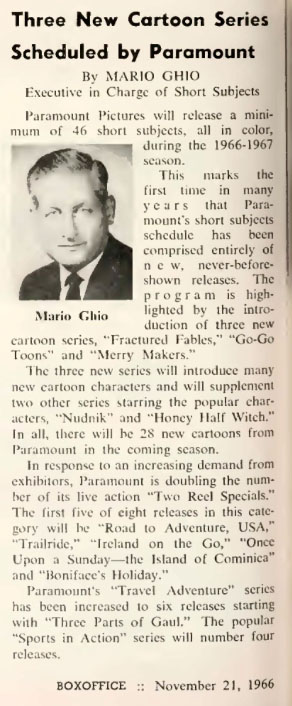
The 1966-67 season marked the end of an era.
It would be the last season since 1916-17 – starting with Bray’s Paramount Pictograph – that Paramount would regularly release a series of cartoon shorts to movie theaters. It would be the end of the line with their association with Max Fleischer’s former studio, an exclusive distribution arrangement that started in 1927-28.
The Paramount in-house studio in 1966 was a remnant of that Fleischer operation, the last strands of Famous Studios… animators Al Eugster, Nick Tafuri and Morey Reden, the last bits of glue to that earlier era.
Shamus Culhane, himself an animator at Fleischers in the early 30s, a directing animator on Mr. Bug and Fleischer’s Popeye in the early 40s, was now steering the ship. To his credit, there are a handful of films – a last gasp – that were noble efforts to achieve something of quality. Unfortunately, an uncaring parent studio and the economics of the changing industry were against him. But at least he had a little fun.
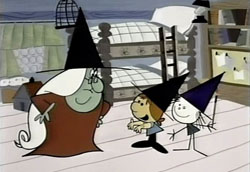 First off, Culhane made some pleasing changes to the existing Honey Halfwitch series. Shari Lewis was now gone, and a real little girl (identity unknown) takes over the voicing. Instead of an enchanted forest, Honey and her cousin Maggie now live in a house atop a skyscraper in mid-town Manhattan. Dante Barbetta, Dave Uninas and Howard Beckerman did a pleasing re-design of the characters and settings. Howard Post is still credited for the stories, and even these are more creative than the previous entries. A child-drawing “Paper Witch” comes to life in one, a magic broom goes berserk in another, Honey concocts private rain clouds – These shorts held potential and proved that Culhane could sustain a regular character if given “half” a chance.
First off, Culhane made some pleasing changes to the existing Honey Halfwitch series. Shari Lewis was now gone, and a real little girl (identity unknown) takes over the voicing. Instead of an enchanted forest, Honey and her cousin Maggie now live in a house atop a skyscraper in mid-town Manhattan. Dante Barbetta, Dave Uninas and Howard Beckerman did a pleasing re-design of the characters and settings. Howard Post is still credited for the stories, and even these are more creative than the previous entries. A child-drawing “Paper Witch” comes to life in one, a magic broom goes berserk in another, Honey concocts private rain clouds – These shorts held potential and proved that Culhane could sustain a regular character if given “half” a chance.
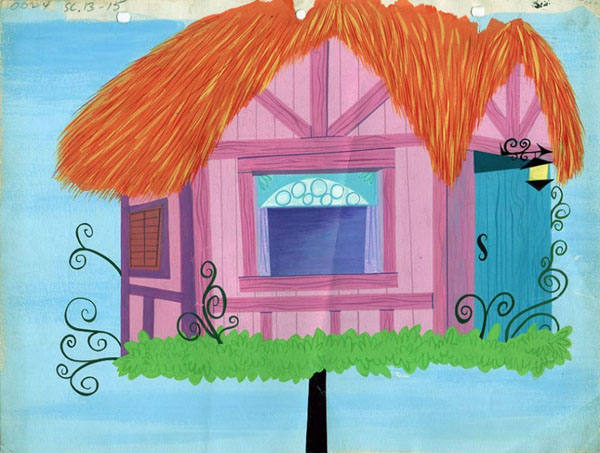
Original BG of Honey Halfwitch’s new home – perched on a skyscraper spire.
Culhane was determined to break with the past and to that end he created three new “series” of shorts. It’s hard to see what exactly differentiates the trio, none of them lasted long – but at a glance it seems the “Fractured Fables” were initially planned to be the series of children’s POV shorts – drawn in child scrawl, narrated by a little boy; The “Merry Makers” were perhaps to house the character series – Hard Hat and Fall Guy, Bosco and Buddy Boy, et al; and the “Go-Go Toons” to present miscellaneous ideas and new experiments.
The first of the Culhane Fractured Fables was a perhaps the biggest success the director achieved at his studio. Apparently the short actually made a profit for the studio, and Culhane declarers it, in his book, “…one of the best pictures I ever produced”! My Daddy The Astronaut is a delightful little film – exactly the kind of “product” Culhane was striving for his new Paramount Studio to turn out. He followed it up with two sequels before his time was up.
In the few existent Culhane Go-Go Toons its clear these films were aimed at modern audiences and he wanted this series to satirize contemporary ideas. But first, Culhane tried to cash-in on the current (1966-67) Superhero/nostalgia fad with The Space Squid. At present, no print of this cartoon is known to exist, but based on a long forgotten interview with Culhane – and the existing musical cue sheet (below) – the cartoon was a space adventure, supposedly done straight. Perhaps Culhane recalled the Fleischer’ Superman cartoons in production when he worked there in the 1940s and was trying a 60s re-vamp. The cue sheet (below) promises giant squid, an Octo-Man, rockets and a “Space Command”. Sounds good to me.
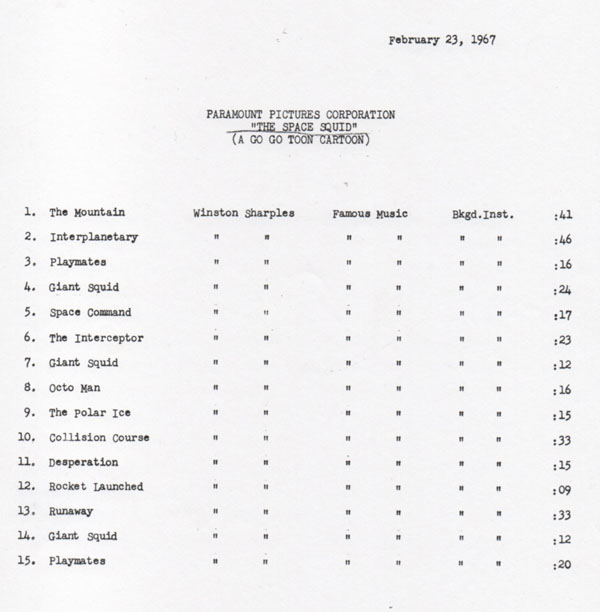
The Plumber is the stand-out here. A simple idea, in pantomime, with designs by Cliff Roberts and Howard Beckerman, the film is a little fable of rags to riches to rags. Well told, visually delightful. I own a Technicolor print myself, and the color really dazzles in this film – Television broadcast and You Tube viewings don’t do it justice.

Keep The Cool, Baby was probably a title they handed to the sales department as an example of the kind of contemporary feel they hoped the cartoons would evoke. This film, in particular, is far from the hippie spectacular one might hope for (that would come a few months later in Bakshi’s Marvin Digs) – this one is an old-fashioned comedy about a spider having a hard time catching his prey. The story was concocted by Culhane and Ruth Kneitel (Seymour’s widow and Max Fleischer’s daughter) – and the graphics, both character design and backdrops, are aesthetically pleasing in a modern vogue.
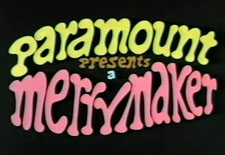 The “Merry Makers” series seems to be for “character” films. Bosco (the elephant) and Buddy Boy (a fox) star in two entries – the first, Think Or Sink, with a story by Jim Tyer (originally written for a Flebus comic book story, published in a Pines Publications Terrytoon comic book ten years earlier) is strikingly contemporary in character design (by Hal Silvermintz) and tone. The film was even submitted and accepted into competition at the International Annecy Animation Festival that year.
The “Merry Makers” series seems to be for “character” films. Bosco (the elephant) and Buddy Boy (a fox) star in two entries – the first, Think Or Sink, with a story by Jim Tyer (originally written for a Flebus comic book story, published in a Pines Publications Terrytoon comic book ten years earlier) is strikingly contemporary in character design (by Hal Silvermintz) and tone. The film was even submitted and accepted into competition at the International Annecy Animation Festival that year.
Culhane was also quite proud of obtaining outside work for his studio – subcontracting the Marvel Super Hero cartoons of Thor from Grantray-Lawrence and producer Steve Krantz. If you look carefully, an occasional “Pow!”, “Bam!” sound effect visual in the late Paramount theatricals were reused from the Thor cartoons.
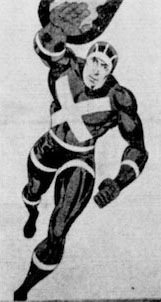
Steranko’s proposed “Agent X”
(Jim Steranko) “was briefly going to have an animated series called “Super Agent X” produced at Paramount. “It was one of the presentations I gave them for a series and it was going to be produced but then Paramount cartoon studios (in New York) folded up right at the critical point and the series was just killed, along with many other projects that I had there. I had a number of shows like ‘Johnny and the Genii’. Oh, I don’t know. There were many,” said Steranko.
Gulf and Western (a manufacturing conglomerate) bought Paramount Pictures in October 1966, and the company suits spent 1967 thoroughly going over the company – and found little need for an animation studio. The profits were just not there. According to Culhane’s autobiography, Shamus put up a vigorous defense for keeping the studio – but the handwriting was on the wall. He resigned (or was fired, as some accounts have it) at the height of the summer of love – joining Steve Krantz (producer of the Thor cartoons) as executive producer on the syndicated Rocket Robin Hood.
Culhane compared his tenure at Paramount to what Frank Tashlin did at Screen Gems in the 1940s and what Gene Deitch did at Terrytoons in the 1950s. I would agree with that assessment. Each one was a unique moment in Hollywood Studio animation history, when a somewhat-creative visionary took the reigns of a studio operation and pursued new ideas, allowed talent to flourish, and pushed some artistic experimentation over established commercial considerations.

“The Plumber”
Burt Hanft met with Ralph and hired him on the spot. Ralph was a coming off his successful career at Terrytoons, loaded with energy and with a successful series (Mighty Heroes) he created/directed for CBS under his belt. Hanft essentially gave Bakshi the same mandate he had given Culhane – get us to television. But first finish the shorts Paramount had promised to theaters. Outside of finishing Culhane’s The Opera Caper (now completely redesigned by Bakshi – see Culhane’s books for images from the original designs), Ralph had free reign to make four new shorts.

Color Models for “Marvin Digs”
And thus it did. After completing the final contracted-for “Fractured Fable”, Mouse Trek, Ralph got the word. Let everyone go. It was over.
It’s too bad – Ralph had several interesting projects in the hopper. He experimented with an animated version of radio’s The Bickersons (see below), using the radio broadcasts for the voice track! He was also drawing up a Mad Magazine/Laugh-in type animated sketch comedy, The Pow Show, when Paramount gave him the signal to shut the place down.
Paramount was now out of the animation production business.
So here they are – the 28 cartoon shorts of 1967, the total mentioned in the clipping at the top by Mario Ghio, Executive-in-charge of Short Subjects for Paramount Pictures at that time.
The 28th cartoon on this list was another independent pick-up – this time from John Hubley, illustrating two Herb Alpert recordings. This film, Herb Alpert and The Tijuana Brass Double Feature (with animation by Bill Littlejohn and Rod Scribner!), won the Academy Award for Best Animated Short of 1966 – a final high note to cap Paramount’s historic role in the distribution (and production) of animated shorts.
 Four (4) HONEY HALFWITCH Cartoons
Four (4) HONEY HALFWITCH Cartoons
ALTER EGOTIST (4/67) Harrington/Crane. When Cousin Maggie forbids Honey from playing with “real kids”, Honey brings a mischievous drawing, “Paperwitch”, to life.
CLEAN SWEEP (6/67) Harrington/Crane. Cousin Maggie and Honey change their look in order to take a busted magic broom to a fix-it shop.
HIGH BUT NOT DRY (8/67) Harrington/Dressler. Left to water the ragweed and toad stools, Honey uses magic to make it rain – but soon cannot control it.
BROTHER BAT (8/67) Harrington/Dressler. When Cousin Maggie goes to the store, Fraidy Bat stops by for a visit.
Six (6) NUDNIK cartoons
WHO NEEDS NUDNIK Gene Deitch. Everything Nudnik does annoys a house wife.
NUDNIK ON THE BEACH Gene Deitch. Nudnik has a awful day at the beach – but wins a surf competition.
 GOOD NEIGHBOR NUDNIK Gene Deitch. Handy man Nudnik lives on an empty lot on a block filled with rich homes.
GOOD NEIGHBOR NUDNIK Gene Deitch. Handy man Nudnik lives on an empty lot on a block filled with rich homes.
NUDNIK ON A SHOESTRING Gene Deitch. In need of a new shoelace, Nudnik explores a department store.
NUDNIK’S NUDNICKEL Gene Deitch. Nudnik finds a nickel – and that’s when his problems really begin.
I REMEMBER NUDNIK Gene Deitch. Nudnik lives in a downtown storage warehouse – and otherwise has a perfectly miserable day.
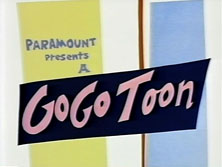 Seven (7) GO-GO TOONS
Seven (7) GO-GO TOONS
THE SPACE SQUID (1/67) Culhane. A “lost” cartoon. Supposedly a sci-fi “adventure”, perhaps to tie-into the pop-art, super hero craze at the time. My guess: it’s something like a combination of Johnny Cypher and Rocket Robin Hood.
THE SQUAW PATH (5/67) Culhane/Eugster/Beckerman. A tribal medicine man (and marriage broker) tries to fix up Geronimo with a new wife.
THE PLUMBER (5/67) Culhane/Beckerman. A plumber blows a tune through plumbing pipes and becomes a musical superstar.
A BRIDGE GROWS IN BROOKLYN (10/67) Harriton/Crane. On a bridge under construction, Hard Hat shows Fall Guy the ropes on his new job as a construction worker.
THE OPERA CAPER (11/67) Culhane/Crane/Bakshi. Two crooks attempt to kidnap a famous opera singer.
KEEP THE COOL, BABY (11/67) Harriton/Crane (written by Ruth Kneitel & Shamus Culhane). A spider gets outsmarted by clever worm.
MARVIN DIGS (12/67) Bakshi/Crane. Marvin and his hippie friends help his dad paint the house.
 Four (4) MERRY MAKER Cartoons
Four (4) MERRY MAKER Cartoons
THINK OR SINK (3/67) Culhane/Eugster. Bosco the elephant explains to a psychiatrist why he believes he can walk on water.
HALT WHO GROWS THERE? (5/67) Culhane. Hard Hat and Fall Guy try to stop a fast growing plant from taking over a construction site.
FROM ORBIT TO OBIT (6/67) Culhane. Another cartoon which seems to be missing. Anyone have a print?
FORGET ME NUTS (8/67) Buddy Boy gets Bosco The Elephant a job working inside a computer.
 Six (6) FRACTURED FABLES
Six (6) FRACTURED FABLES
MY DADDY THE ASTRONAUT (4/67) Culhane/Eugster. Drawn in stick figure child art, a boy talks about his astronaut father.
THE STUCK-UP WOLF (9/67) Harriton/Eugster. Drawn in stick figure child art, a boy tells the story of “Red Robbin” Hood”.
THE STUBBORN COWBOY (10/67) Harriton/Eugster. Drawn in stick figure child art, a boy tells the story of a cowboy who won’t listen to advice.
THE FUZ (12/67) Bakshi/Crane. Superheroes Super Basher and Bop rescue Poopsie from the “fuzz” that’s following her around.
THE MINI SQUIRTS (12/67) Bakshi/Crane. The typical life of a modern married couple, as enacted by little boy and little girl.
MOUSE TREK (12/67) Bakshi/Crane. An Earth cat is abducted by alien cats who bring him to a planet terrorized by a giant mouse.
One (1) Special Release
HERB ALPERT AND THE TIJUNA BRASS DOUBLE FEATURE (12/66) John Hubley. Animation to illustrate the songs Tijuana Taxi and Spanish Flea. Winner of the Academy Award for Best Animated Cartoon of 1966.

NEXT WEEK: 1968 and Beyond…
(Special Thanks to Ken Layton and Mike Kazaleh for their assistance)


 Jerry Beck is a writer, animation producer, college professor and author of more than 15 books on animation history. He is a former studio exec with Nickelodeon Movies and Disney, and has written for The Hollywood Reporter and Variety. He has curated cartoons for DVD and blu-ray compilations and has lent his expertise to dozens of bonus documentaries and audio commentaries on such. Beck is currently on the faculty of Cal Arts in Valencia, UCLA in Westwood and Woodbury University in Burbank – teaching animation history. More about Jerry Beck [
Jerry Beck is a writer, animation producer, college professor and author of more than 15 books on animation history. He is a former studio exec with Nickelodeon Movies and Disney, and has written for The Hollywood Reporter and Variety. He has curated cartoons for DVD and blu-ray compilations and has lent his expertise to dozens of bonus documentaries and audio commentaries on such. Beck is currently on the faculty of Cal Arts in Valencia, UCLA in Westwood and Woodbury University in Burbank – teaching animation history. More about Jerry Beck [



































Paramount’s product in 1967 went from being just about the least interesting releases of any of the studios still doing theatrical shorts (possibly ahead of only Paul J. Smith’s output at Lantz) to being the most interesting, in terms of both story and design.
“The Plumber” uses the same basic story line as Chuck Jones’ “Nellie’s Folly” from six years earlier (even the abstract clapping hands of the theater patrons are similar), but Culhane doesn’t fall into the trap Jones got himself into at the finish and produces a logical, but uplifting ending, as opposed to one with an ‘imaginary’ ending following an implied suicide by the title character.
One of the advantages of the child-like style of animation here or in the Howard Post-Jack Mendelson efforts from 1965, was that it turned the limited budget liability into an asset. You didn’t have to move the character fluidly or keep the character on model, because that’s not how a child would do it.
Nelly’s Folly’s ending was a hard pill to swallow compared to the uplifting “never-give-up” spirit of “The Plumber”. And yes, those early “Fractured Fables” certainly showed the strengths in how limited animation could be used in a manner that best exemplified the means.
Just as an aside, I must really have never paid attention when I watched “Nelly’s Folly”. My interpretation of the ending was that Nelly decided to cast off the trappings of fame and ran off back to the jungle to be with those who truly appreciated her talents, while telling no one who could come after her and try to coax her back.
From the time I first saw the short as a kid right up to the present I never took the ending to imply Nelly offed herself.
I suppose it depends on how one views a film. I personally though she went back too, but reading the other guy’s comment, I can see how one may interpret it that way given how the scene shifts from the city back to the jungle, let alone the way the narrator suggests the idea of her leaving town even though we’re not given any clear reason Nelly did so. It is left up to the viewer.
Another fascinating post. Culhane had an amazing animation career well worth further study. The child-like drawing technique was also used to good effect in UPA’s 1951 release “The Family Circus” which I believe was directed by Art Babbitt.
Will next week’s 1968 and beyond Paramount thing mention the Casper revivals done by Hanna-Barbera (1979) and Universal (1996)? But I don’t think it will mention the Hanna-Barbera Popeye revivals.
And I bet the 1968 and beyond article will mention that ill-fated 1991 Casper and Friends syndication package which featured redubbed voice tracks of the Paramount/Harvey cartoons before the original voice track versions were bought back for its second year in syndication.
I glad you’ve been enjoying this series of articles, but I’d appreciate it if you would comment on this post – and resist guessing what I’ll be discussing in the next one.
For the record, I will not be writing about the subsequent revivals of Casper or Popeye – or Superman, Little Lulu or Baby Huey – Come back next week and be surprised.
Maybe we might see how the earlier shorts lived throughout the decades after the studio closed, such as when Turner got his hands on the black-and-white Popeye cartoons and started splashing color on them.
Remarkably, I have a lot of 16mm Tech prints of cartoons released during this final season, including “The Plumber” and “Marvin Digs”.
At the very least, I think Paramount ended their cartoon run with a bang; few of those last films were entertaining, at least.
11/23/15
RobGems.ca Wrote:
I saw your screencap of Shamus Cullhane’s “Honey Halfwitch” in this blog. Although it was over fifteen years since I seen the “Honey Halfwitch” series on Nickelodeon TV, the design I saw was just exactly as I remembered it: a totally different design and characterization for Honey from the earlier version by Howie Post. I also remembered seeing the “Paper Witch” episode back around 1994-96 with Cullhane’s designs and backgrounds. As for the story line, it seems that “Spongebob Squarepant’s” creator and writers re-cycled the idea of a trouble making “double” some near 40 years later (named “Franken-Doodle”), only the troublesome “Spongebob” was made out of crude pencil designs. Seems like cartoonists find it pretty hard sometimes to think up new and improved ideas, so they dig up ideas from old cartoons decades earlier. I also remember seeing “The Plumber” cartoon on “Weinerville” around the same time; It looked like it was drawn by the folks at DePatie/Freeling Studios, so I was surprised to learn that it was a late-period Paramount Cartoon from 1967. The different designs in that cartoon were far and away removed from the old-fashioned animation and characters of the Fleischer Brothers heyday, but at least it’s interesting, and better than some of Paramount’s weaker cartoons of the 50’s and early 60’s. I didn’t get to see “Marvin Digs” until early 2009 on the YouTube Video channel; all I can say about that one is “Far Out, Man!” (to use a dated expression of the period.)
Thanks Jerry for these very informative articles chronicling the history of Paramount cartoon studios. Learned a lot from each post.
http://www.patcartoons.blogspot.com/
I assume that Crane is Doug Crane. I know he had worked for Paramount, but he’s best known to me for his comic book work for Tower , DC, and Archie. All teen humor work, done intermittently through the years. Is there a short bio / resume of him?
How was his animation?
Yes, it was Doug Crane. A few other Terrytoon alumni have also showed up with Bakshi on these final shorts like background aritst John Zago and Cosmo Anzilotti who did layouts on Ralph’s films here.
John Zago had been at Famous Studios in the 1950’s. I assume he was laid off at the same time Dave Tendlar, Myron Waldman and many others were in 1957.
On the other side of the country, STAR TREK, a live action show which would later be animated, was also receiving a close scrutiny after Paramount had bought up Desilu. Did those accountants close the animation studio to pay for Desilu? Hmmm, could be?
Interesting theory.
Reminded a couple years later, Gulf+Western would pick up a little known arcade company known as Sega.
So no Popeye re-releases that season?
Still boggled by the fact they’re STILL doing live action shorts, albeit all in the documentary / travelogue vein. I remember “featurettes” as being the dominion of Disney, which produced True Life Adventures and the like to support short-lengthed animated features.
I suppose that lasted a few more years if they weren’t already gone by the early 70’s. Disney of course released it’s live-action/animated combo “It’s Tough To Be A Bird” which garnered an Oscar in ’69.
So no Popeye re-releases that season?
No. The 1965-66 season had been the last one for the Popeye Champions reissues.
Man, it’s a bittersweet ending to an era. A forgotten era. It’s too bad Gulf + Western didn’t see the market for cartoons.
This was Paramount’s cartoon hertiage!
There are times when I sorta wonder how it could’ve been had they simply did TV shows for saturday morning into the 70’s that way. Some movie studios simply didn’t see a need to get into that it seems.
I find it odd that there should be lost films from the sixties by a major studio. You expect this from the silent era or from small independents. Was this an indication of how little they cared about these cartoons?
Anyway, this has been a great series of posts. I have grown up on much of the Famous Studios cartoons, and it has been interesting to revisit them and learn something about the people who made them. Keep up the good work!
There are PLENTY of lost films from the 1960s and 70s as people at the time didn’t regard them as quality, or more significantly, ownership switched hands from one company to another and film copies and record keeping became more and more erratic. It’s not just a problem of the silent movie era. I learned this when trying to compile the Total TeleVision cartoons for DVD and the current owners had cartoons without audio or cartoons were missing all together.
TV shows used to be regularly wiped well into the 1970s and significant shows like the first Johnny Carson Tonight Show are missing (except for audio of Groucho Marx’s introduction) and studio fires help destroy a lot of inventory and just general carelessness.
The interesting byproduct of today is with things like YouTube and other streaming services as well as social networks, is that the most insignificant thing ever recorded is literally preserved forever as long as the Power Grid holds out, since things are replicated ad infinitum in countless servers around the world.
There are PLENTY of lost films from the 1960s and 70s as people at the time didn’t regard them as quality, or more significantly, ownership switched hands from one company to another and film copies and record keeping became more and more erratic. It’s not just a problem of the silent movie era.
It is truly sad.
I learned this when trying to compile the Total TeleVision cartoons for DVD and the current owners had cartoons without audio or cartoons were missing all together.
I noticed that with the Tennessee Tuxedo set personally. Some cartoons had visuals that looked decent while the audio sounded rough with a lot of static. One episode even looked to have been taken from someone’s recording off of Nickelodeon when they aired Underdog in the 90’s!
The interesting byproduct of today is with things like YouTube and other streaming services as well as social networks, is that the most insignificant thing ever recorded is literally preserved forever as long as the Power Grid holds out, since things are replicated ad infinitum in countless servers around the world.
That is true (or saved on some digital form unless that gets rendered obsolete the way things do.
Thanks Mr Beck. These articles on the final decades of Famous/Paramount were great! Seems the studio went out on a mid-high note in spite of a lot of bad cartoons.
One brief correction regarding Jim Steranko. You refer to him as “Marvel Comics creator,” however it would be more accurate to call him Nick Fury Agent of SHIELD creator or its artist/writer. That was the only Marvel property he ever got to work on, yet the artwork was so striking in addition to be one of the few series allowed to have both a writer/artist (mostly the writing was done by Stan Lee or his like-minded assistant Roy Thomas) that he was achieved cult status through that one series alone.
What is amazing is that Steranko caught Culhane’s eye as early as 1967, given that he never really achieved wide acclaim for his work until years later. John Romita and Jack Kirby definitely had more of a reputation. Perhaps they could not be afforded the extra time to work on an outside animated series (Kirby for certain)?
This also would coincide to why he was chosen to work on a series called “Agent X”
It’s also interesting to note that the short subjects died out around the time of the so-called Silver Age renaissance of comic books. Poor timing considering those could have easily made a good investment on a series of then-popular hero shorts featuring, say, Spider-Man. The Fleischers were certainly keen to know when the iron was hot .
Steranko also did a couple issues of both X-Men (50, 51) and Captain America (110, 111, 113). And before working at Marvel he briefly did some stories and characters for Harvey Comics, one of which was called Spyman — another secret agent type character.
There is one more Paramount cartoon release for this season not noted here, “Boniface’s Holiday”, a two-reel “special”. It’s a pick-up from the Russian Soyuzmultifllm studio and seems to be adapted from a children’s book about Boniface, the lion. So please add that one to the Paramount cartoon release history, Mr. Beck.
Wow! I didn’t realize Boniface’s Holiday was an animated film and neither did they – they refer to it as a live action short in the article atop the post. And what a great film by Fyodor Khitruk!
Thank you Mr. Kausler!
Now I wonder who would’ve been stuck narrating this in English? There’s a mystery to solve!
Jerry, I love these articles….learning more each day. Thank you…
Worth mentioning that the Bosco Elephant character (THINK OR SINK & FORGET ME NUTS) was voiced by the legendary impressionist Will Jordan. He narrated the opening and did a funny Andy Devine voice for the elephant. Will told me that did three cartoons in this period but so far I haven’t found the third one…he recalled doing a zany German. Of course he had totally forgotten his much earlier Paramount cartoon recorded back in 1960, COOL CAT BLUES, for which he did a Cary Grant and his famous Ed Sullivan imitation. Although Chuck Harriton gets director credit on the second Bosco, Will recalls Shamus attending the recording sessions.
That’s great info, Keith. Perhaps Jordan played a German scientist in FROM ORBIT TO OBIT, a cartoon I know nothing about and is seemingly nonexistent (except being on studio release charts and mentioned in Culhane’s book). It would make sense that a third “Bosco and Buddy Boy” film would be the missing “Merry Maker” short.
I have a vivid memory of the Herb Alpert double feature. In the late 60’s there was a TV special on one of the networks titled “The Fabulous Shorts” and as I recall it presented a wide sampling of animated short subjects–Disney and many others. “Spanish Flea” and “Tijuana Taxi” are the ones I remember best. While some of the shorts were played in their entirety, others were represented in clips with narration describing them. This double feature was one of the former. I believe “The Old Mill” was also shown uncut and uninterrupted.
If the documentary was in ’68 or ’69, which I’m thinking it was, then this piece would have been one of the most recent ones shown at that time–created just a year or so previously.
As usual, our whole family gathered around the TV to watch the special–friends had recommended it as something they thought we might all like to see. When it became clear that the documentary was about cartoons, the usual one-by-one exodus happened and I was the holdout who remained watching, mesmerized. Alas, I was the only one in our family who could appreciate animation as art. Everyone but me missed out on the Herb Alpert piece, which impressed me then and still impresses me in seeing it again today!
Thanks for this post–fascinating history and the rekindling of old memories.
I remember that special! It was hosted by Jim Backus, and the program included a brief excerpt from the early Columbia/UPA version of Mister Magoo, the one in which he’s on an airplane. I don’t remember “The Old Mill” but the show did include the animated version of Jules Feiffer’s “Munro” in its entirety. I remember the Tijuana Brass segment as well. I’d love to watch that show again.
That Mr. Magoo cartoon would’ve been “When Magoo Flew”. Sounds like an interesting special, don’t suppose a master of that exists at all these days, though I see Lee Mendelson produced it. IMDB lists Mel Blanc also appearing in this too.
I hadn’t realized that Shamus Culhane’s My Daddy the Astronaut, plus his 2 other childlike shorts owed so much to my earlier Jacky’s Wacky World cartoons. Oddly enough, Al Eugster — who did such a magnificent job on my Story of Geo. Washington, did an equally spectacular job on Culhane’s 3 theatricals.
I think even Eugster knew that as Culhane pointed that out in his book of his involvement on your shorts, Jack. It’s nice to know he was able to adapt to any style and approach available then.
That’s probably why I thought that “My Daddy the Astronaut” was your work.
On a related note, I’m glad to see that your “Jacky’s Diary” comic strip has been reprinted not long ago.
The Stubborn Cowboy is Lost Cartoon
Always neat to see the end of an era portrayed, especially for a studio that’s not gotten it’s due. I remember some of these, they remind me of the Luno-Deputy Dawg Terry toon stuff from then. Good stuff Jerry!
It’s notable that Steranko contibuted to X-Men history by designing the long standing three dimensional X-Men logo.
The Herb Albert & The Tijuana Brass Double Feature consistent of three songs,
1-The Mexican Shuffle (which a portion was played in the opening credits)
2-Spanish Flea about a flea from the countryside invading a posh resort
And
3-Tijuana Taxi about the TJB’s harrowing trip crossing customs via a taxi to get to the airport to catch their flight.
This I believe that this was the first animated film that was the precursor to today’s videos and winning the 1967 Oscar for best animated short was a milestone for Paramount Studios.
Aside from being used in the opening credits, I assume “The Mexican Shuffle” wasn’t included as another tune to illustrate given the “Double-Feature” of the two other songs.
“The Mexican Shuffle” was used in commercials for Clark Teaberry gum a year or two later.
I read an article in one of the motion picture trade magazines from the late ’60s which talked about how the bottom had fallen out of the market for animated shorts. The explanation offered there was that theater owners were willing to book cartoons as long as the target audience for movies was the entire family, but by the mid-late ’60s that was no longer the case, and theater owners felt there were too many movies coming out, movies aimed strictly at adults, with which cartoons simply weren’t a good fit.
The X-rated genre was certainly testament to that.
This SPACE SQUID thing intrigues me. It’s always shocking to learn that a film produced since I was born is considered lost. The cartoon, itself, would probably be no great shakes, but it sounds so off-beat that I’m curious…
Have to wait for someone to discover a print in a church apse in Belize…
Have to wait for someone to discover a print in a church apse in Belize…
Sometimes it is in the least place you could think of, like the missing footage used in restoring Fritz Lang’s Metropolis being discovered in some film library in Buenos Aires.
“The Bickersons” was that supposed to be a theatrical release or was that supposed to be the first TV cartoon?
Now, these days, the cartoons from Paramount from 1962 to 1967 is unlikely be on television today.